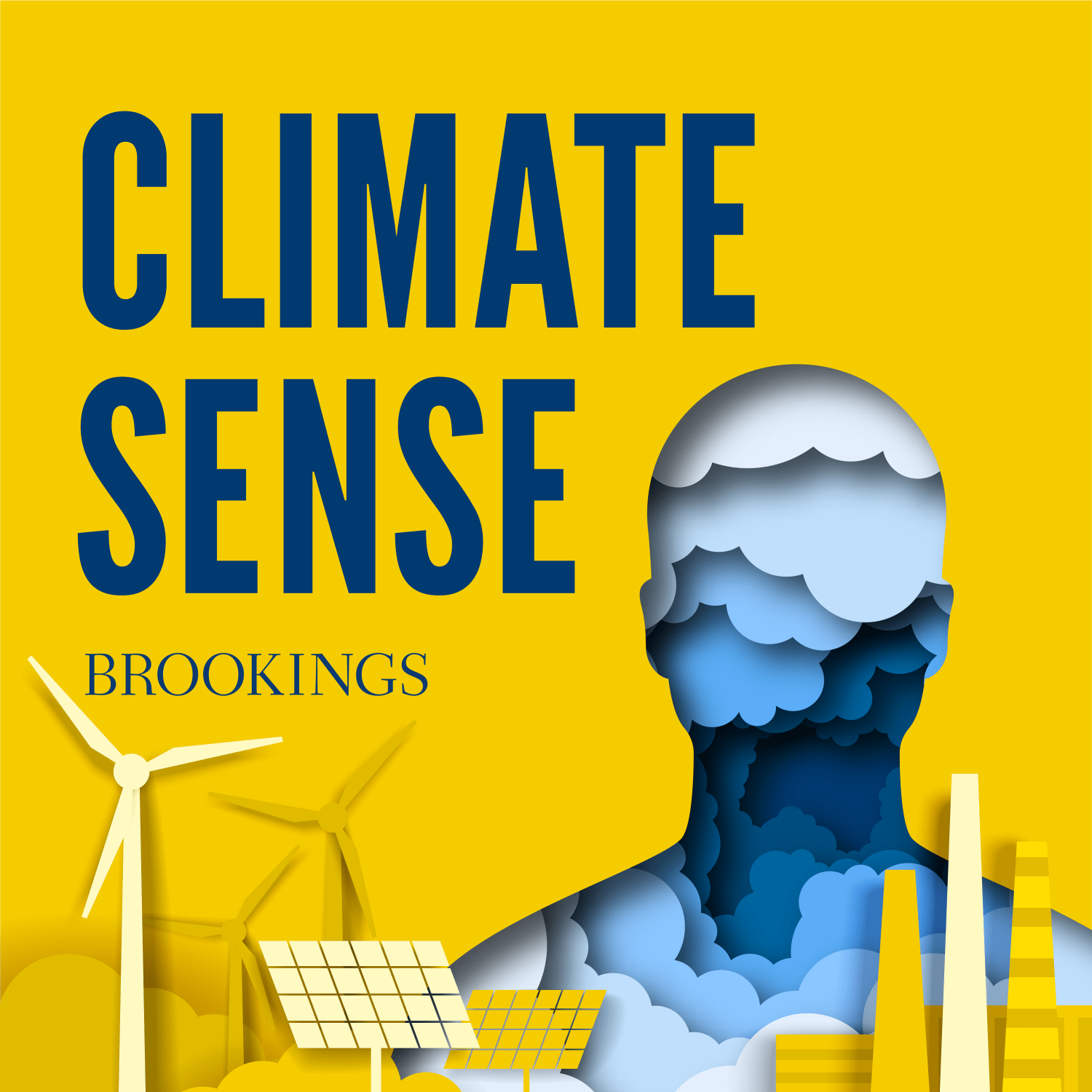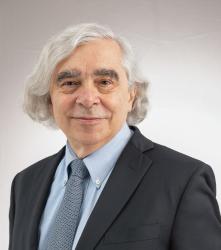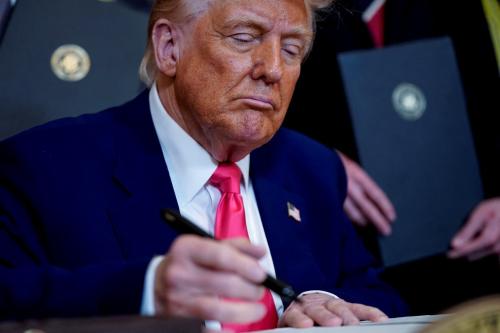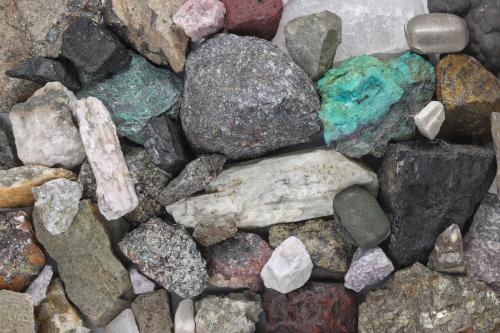The world needs emissions-free electricity that is available when and where we want it, rather than on Mother Nature’s schedule as wind and solar generation are. Nuclear power has the potential to be that source. In this episode, host Samantha Gross talks with former U.S. Secretary of Energy Ernie Moniz, who says that fission reactors, the kind in use today, have the potential to become safer and less expensive. And fusion reactors, long the holy grail of carbon-free energy, are quickly moving from science fiction toward reality.
- Listen to Climate Sense on Apple, Spotify, or wherever you like to get podcasts.
- Learn about other Brookings podcasts from the Brookings Podcast Network.
- Sign up for the podcasts newsletter for occasional updates on featured episodes and new shows.
- Send feedback email to [email protected].
TRANSCRIPT
MONIZ: We are going to need power that’s available when we want it, when we need it, where we need it. Nuclear power is one of the prime options for supplying that.
[music]
GROSS: Oldsters like me have seen a lot of change in nuclear power in our lifetimes. Nuclear power was once touted as bringing us electricity “cheap to meter,” a phrase coined by the US Atomic Energy Commission’s chairman in 1954. But real-world costs dashed that hope. Not to mention accidents: the partial meltdown at Three Mile Island in 1979 is the worst nuclear incident on U.S. soil, while much worse accidents at Chernobyl in 1986 and Fukushima in 2011 were disastrous for people and the environment alike.
But concern about climate change has brought new interest in nuclear power, since it can produce large amounts of steady electricity supply with no greenhouse gas emissions. Can nuclear power be a safe, affordable, and trusted part of our energy system?
[music]
I’m Samantha Gross. I’m the director of the Energy Security and Climate Change Initiative at the Brookings Institution and I’ve spent my career focused on energy and environmental issues. I’ve been in Washington, D.C., for 20 years, working on energy policy in government and private industry before I came to Brookings. But I started my career as an engineer, designing technical solutions to environmental problems. My work now focuses on how to transition to a clean, zero-carbon energy system—the technical, political, and social challenges in getting from here to there.
Joining us again for this episode is Ernie Moniz, former U.S. secretary of energy and one of the world’s most prominent experts on energy in general, and nuclear energy in particular.
When we think about dealing with climate change, wind and solar power generation are the first solutions that come to mind for most people. And for good reason—removing carbon emissions from our electricity system will be central to decarbonizing our energy system as a whole, as we talked about in the electricity episode last season. But we know that these sources are available on Mother Nature’s schedule, dependent on the weather, not on a schedule that people can dictate. And that is a challenge.
[2:52]
MONIZ: As we go to the clean energy transition, first, there’s no doubt that the lead horse, if you like, in decarbonization has been and will continue to be the electricity system, the grid.
As that occurs, I think that some of the euphoria of years past has given way to practicality. Meaning that we are going to have enormous contributions, certainly, from wind and solar, which have grown dramatically and which we think still needs another hundreds of gigawatts just by 2030.
I think there has not been enough focus on the fact that being weather dependent for certainly the totality of the grid is not the place you want to be.
We, for example, have mapped for one year the availability, the dispatch of wind and solar in both Texas and California. We saw a very similar pattern, that roughly 90 days of the year, for example, wind was not available in either state. Not at the same time. The seasonality is different in different places. But both had about a quarter of the time with insufficient wind. And when you have 90 days in a year, it’s not surprising that you’re going to have fluctuations of nine, 10 days in a row. And both states, in fact, had that as well. So, you can’t run a system where you say, well, okay, it’s only once a year that we don’t have the juice for nine or 10 days.
Now, solar is a little bit different. It doesn’t have that kind of variability. However, solar has another variability that is seldom mentioned, but it’s obvious. It’s associated with something called latitude. And at our latitude, the solar insolation is roughly, let’s say, double that of the winter in the summer.
[music]
So, it’s not that you can’t plan around that, but the fact is, there is very, very large variability seasonally with solar. It must be taken into account.
GROSS: People want power when they want it, rather than when mother nature says we can have it. Storing wind or solar power could be an option, but for those nine or 10 days when it isn’t windy, or for the winter months when the sun just isn’t giving us enough juice, a little bit of storage just doesn’t help that much. We need something else, something steady.
[5:25]
MONIZ: However, the practicality is that I think we’ve also come to realize that we are going to need firm power, power that is dispatchable as a balance to variable power. By firm power, what I’m referring to is that it’s power that’s available when we want it, when we need it, where we need it.
Frankly, nuclear power is one of the prime options for supplying that. We have many challenges, as we know, but natural gas will play a critical role in the transition, but eventually the carbon from natural gas is going to have to be taken care of, perhaps through carbon capture and sequestration. There’s some revived discussion about engineered geothermal.
On the longer horizon, perhaps, there’s maybe nuclear fusion power. But the reality is when you think about zero carbon electricity, and the need for considerable amounts of firm power, we don’t have all that many options to be perfectly straightforward about it.
GROSS: As we talked about in the electricity episode last season, we don’t just need decarbonized electricity, we need more electricity for the energy uses we want to electrify, like transportation and home heating. This increase in electricity demand is known in the industry as load growth.
[6:47]
MONIZ: Another issue today of tremendous importance as we look at the grid and as we look at decarbonization is a lot of utilities have been surprised at the load growth for electricity that is now coming online. We’ve had terrible underestimates made about the load growth over the next five or 10 years in many parts of the country as huge data centers come online; new manufacturing—partly inspired by the administration’s climate policy; as we look forward to further electrification in the vehicle sector, for example; heat pumps across many, many, sectors, that load growth is another kind of challenge, and things like intermittency and seasonality are major challenges, let’s say, if you want to run a data center 24/7.
And one should not underestimate the scale. It’s becoming clear that individual data centers will soon be approaching a gigawatt of capacity requirement. This is a big issue and we’re going to have to get a grid system put in place that will span the variability of wind and solar with some storage, battery storage, for example, but also with lots of firm power.
GROSS: Wow, a gigawatt was a bigger number than I thought you were going to say right then.
MONIZ: It is stunning, but we already are seeing 900 megawatts, and I know in one particular state there’s already a plan for a gigawatt data center. This is absolutely stunning, and how the utilities will meet this challenge, especially in the nearer term, while at the same time adhering to their carbon reduction goals is going to be a real trick and we and many others are really focused on this challenge.
GROSS: For comparison, a gigawatt is enough electricity to serve 750,000 homes. That is a lot of power!
[music]
Nuclear power has a checkered reputation for sure. If we are going to enjoy the advantages of nuclear—that it can generate a lot of emissions-free electricity when and where we want it—firm power—we also have to address the challenges of nuclear power.
Let’s go through those challenges one by one, beginning with cost. We hear about massive cost reductions in solar power, but we have to remember that it’s available when Mother Nature says it is. Nuclear power is a different product, available when we want it. It’s more expensive to build today, but can we bring costs down?
[9:38]
MONIZ: When the statements are made about how inexpensive wind and solar are, that’s really at the margin. And when wind and solar are small compared to the overall supply, that’s fine, because frankly, to be perfectly honest, we all know today natural gas is the workhorse in the United States electricity system. And it can be firm, it can take care of the variability of renewable sources.
But as we go to, again, much, much deeper decarbonization, and much, much greater penetration of wind and solar, which we all anticipate and look forward to happening, then the ancillary costs, if you like, of storage at a wide range of timescales makes the cost of those renewables more realistic, shall we say.
I think a key issue going forward is getting that cost of new nuclear down. And there’s a couple of points there that make this a credible proposition. Number one is as we confront issues like load growth, as we confront issues such as decarbonizing in a greatly electrified energy economy, will we get away from what we would call the project mentality? Building one or two large reactors and then have a long fallow period where all the learning that’s happened is basically dissipated? If you look at the reactors being built today in Georgia, in the United States, the entire commissioning process of the second of the two identical reactors in the same place is really occurring at, let’s say the order of half the cost and time of the first of the new reactors.
And similarly, if you look at the United Arab Emirates. They are nearly finishing a construction project, South Korean design, of four reactors. They’ve had exactly the same experience. Dramatic learning as one builds a reactor. So, one major question is whether it’s gigawatt scale reactors or the newer small modular reactors, will we be able to have an order book of sufficient commitment to a particular design such that investments in supply chain are made, learning effects are captured, and drive down the costs dramatically more into that range of what I would say are the renewables plus multiple storage options cost?
GROSS: Experience around the world today, including in the United States, shows that learning really works to bring down costs. It’s natural to think that the more reactors we build, the better we will get at it.
[12:32]
MONIZ: If that order book is there with enough commitments, then you would think that you’d be able to have those investments in a supply chain including manufacturing all or most, at least, of the nuclear core of the project in a manufacturing environment. And we all know that manufacturing environments in any field have always led to significant cost reductions with learning. And part of that learning is because in the manufacturing environment, you also have a stable, well-trained workforce. And that’s much harder to do when you have a project mentality of one reactor here and one reactor there, where here and there may be quite widely separated.
So, there are, I think, reasons to think that we can get those costs down substantially.
[music]
But it probably requires a transition from a project mentality to a product mentality much the way, you know, Boeing or Airbus turn airplanes off of their production lines.
GROSS: I love the comparison to manufacturing airplanes. They are incredibly complex structures where failure is life-threatening. Not all that different from a nuclear power plant when you think about it. The airplane manufacturers accomplish this by having enough steady orders for airplanes to manufacture parts in a controlled environment with a very well-trained work force. Imagine how difficult and expensive it would be to build airplanes as one-offs in a hangar somewhere. That’s the way we’re building nuclear power plants today, and what the “order book approach” that Ernie describes is trying to end.
A new type of nuclear reactor is getting a lot of attention right now: small modular reactors.
[music]
An important reason for considering smaller designs is that they would be easier to deploy in the way that Ernie describes, with an order volume of multiple reactors, allowing manufacturing of components and learning by doing. The great hope is that these attributes would make building reactors less expensive and nuclear power more cost competitive.
[14:54]
MONIZ: So, the small modular reactors, and there are many, many different designs out there—well, first of all, they’re small relative to the large gigawatt, gigawatt plus reactors that are the workhorses today for nuclear power in the United States and elsewhere. We might think of them as in the 100- or even 50-, 70-megawatt to, say, 300 megawatt, to have some fairly arbitrary boundaries for the definition of small.
So already, that does have implications, for example, for financing structures. One can imagine the ability to commit less capital at one time while building up still a utility scale operation.
There are various designs, and I would just bin them for the moment, at least, into two. One are so-called generation three plus designs, which are fundamentally light water reactors built to a smaller scale than today’s reactors but drawing on a lot of experience from many many decades of building and also very importantly licensing light water reactors. The Nuclear Regulatory Commission’s experience base is virtually 100% light water reactors. So, that gives that kind of design a substantial leg up. But it’s also important to incorporate some new features, such as so-called passive safety, for example, in these smaller systems.
I anticipate that the first deployments of small modular reactors for electricity production will probably be of the light water reactor type, given its advantages of speed to market, from experience both technically and regulatorily.
GROSS: All nuclear power plants in the United States today use light water reactors. The change toa small modular reactor is in size, not in technology.
[17:00]
MONIZ: There is an a very interesting whole other set of small modular reactors often called Generation IV. These can be high temperature gas reactors, or molten salt reactors, or sodium cooled reactors, and we could go on. They have many attractions, at least in in design, in terms of safety. But of course, as we’ve already said, they are not technologies with a lot of experience. And so, one has to expect as with any new direction that there will be probably be higher first of a kind cost penalty to be absorbed. It’s always hard to be the first as opposed to being the third or the fourth.
However, they do have a distinguishing feature, which, again, is the operating temperature. Well, a high temperature gas reactor, the name itself says that. And today, one reactor of that design has been at least nominally contracted with to provide not electricity, but process heat in the industrial context. So, the operating temperatures are significantly higher than light water reactors, which gives higher quality heat.
Don’t get me wrong, it’s not a high enough temperature to manage all of the industrial heat requirements, because some industries require very, very high temperatures. But a lot of the industrial heat requirements in particular could be managed, I mean some, by light water reactors, but many more by these generation IV reactors.
But we haven’t gotten over the hump yet, if you like, in terms of actually building these Generation III+ or Generation IV reactors.
[music]
And when we do so, I’m hoping it happens through something like this order book approach where we can right from the beginning be able to take advantage of the cost reduction opportunities that that will provide.
GROSS: These high temperature nuclear reactors are exciting in their potential to help with industrial decarbonization. You might remember from last season that very high process heat is one factor that can make an industry hard to decarbonize, as in steel or cement. Today, you generally have to burn something to get very high temperatures, and that something is almost always a fossil fuel. These nuclear plants could not only provide power, but also provide an alternative to hydrogen for very high heat processes. Cool!
I said earlier that to take advantage of nuclear power, we need to overcome the problems that have dogged it in the past. Nuclear waste is clearly one of those problems—spent fuel from nuclear reactors is dangerously radioactive for thousands of years. Here in the United States, the argument over permanent disposal of waste from nuclear power plants has gone on for decades without resolution.
Safety is another key area of concern. The overwhelming majority of the world’s nuclear power plants have operated safely for decades, but the dramatic accidents at Chernobyl and Fukushima demonstrate that splitting atoms can be a dangerous business.
[20:20]
MONIZ: To start with the waste issues, the nuclear spent fuel, let me first of all say that any reactor of any type in any fuel cycle that is based upon fission is going to have fission products. Roughly speaking, you tell me how much heat you produce from fission, and I’ll tell you how many fission products you have.
And the fission products, the products you get by splitting uranium into smaller chunks, those chunks are radioactive. And in fact, the radioactivity of the fission products and their progeny is what dominates the radioactivity and the heat from the from the waste for centuries. So, frankly, we should not imagine that there are some magic way of eliminating those fission products from a fission reactor.
Now, there are different ways of handling it and managing it. First of all, I have to say that I have not seen any technical, scientific reason to think that geological disposal of irradiated fuel is not safe for the very long periods of time that are that are called for.
Now, how that is done, however, there are variations. And I will confess to having my own my own favorite, for example, which is what are called deep boreholes, rather than mined repositories, going instead to drilling much smaller diameter holes very, very deep, many thousands of meters, and disposing of the fuel in that way. So, there are options and I think that that is quite credible.
GROSS: These boreholes are very deep, much deeper than groundwater that people use.
[22:04]
MONIZ: Frankly in the United States, we have not exactly made a lot of progress in terms of long-term disposal. There remains a lot of interest in what I believe to be the correct—it’s always been the correct in my view—first step, which is long-term storage above ground or in a basement, if you like, so called dry storage, which we believe can certainly be done quite safely for a hundred years.
In my view, the right approach is to do exactly that. Perhaps consolidate the irradiated fuel into a few locations, perhaps under government ownership and control, potentially, and have that for a hundred years. Let the fuel cool off in both heat and radioactivity. And then proceed to geological disposal, whether it’s a mined repository or the deep boreholes that I would like to see pursued.
That is not to say that the irradiated fuel is unsafe in the distributed way that we have today in the United States. It’s just that I think it’s good hygiene and good business practice to move it away from the sites, take it away from the utility requirements of management. Stop the considerable federal payments to the utilities for storing the fuel when legally it was supposed to be moved out by the government. My view is let’s get on with it. And that’s part of the necessary, or at least, in my view, desirable expansion of nuclear power for that low carbon firm capacity that we will need in a reliable, resilient, expanding electricity system.
GROSS: Although nuclear waste is a big sticking point, the concern that stands out most in many people’s minds about nuclear power is safety.
[23:56]
MONIZ: With passive safety there are various designs, but fundamentally what it amounts to, especially in in the smaller reactors, is that things like natural convection can be relied upon so that if power is shut off to the reactor it will remain in a sufficiently cool state, for example, to go forward. So, there’s lots of technology in a new generation of reactors that we can look forward to.
In my view, ultimately, to provide nuclear generated energy but without any waste problem, and without any possible proliferation leak, et cetera, would be to go to nuclear fusion.
[music]
GROSS: Ah, fusion, the holy grail. I feel like I’ve been hearing about nuclear fusion for my whole career. Some of you might remember the fiasco of “cold fusion” back in 1989, when scientists claimed they had fused hydrogen atoms at room temperature and promised inexhaustible clean energy. After that, “cold fusion” became synonymous with sloppy science.
But fusion isn’t a joke anymore. Scientists and engineers are getting closer all the time to this new source of energy.
[25:16]
MONIZ: Nuclear fission, today’s reactors, are based upon splitting a very heavy nucleus, particularly uranium, into smaller pieces. And the curve of binding energy tells you when you do that you are releasing a lot of energy, and that’s today’s nuclear power.
However, the curve of binding energy bends over, and when you go to very light nuclei, like hydrogen, when you fuse them rather than fission them, that is have them actually join together into a heavier nucleus, that also releases a lot of energy. But in this case, what you produce does not have any of the radioactivity or continued heat generation that you have with fission.
So, if we can manage to get fusion to be a workhorse in our electricity system, it would have all the benefits of today’s nuclear power, namely very high energy density, for example, firm power, but without the waste challenge at all. I mean, there is waste like activated materials, et cetera, but nothing like the long-term, high-level waste which we were talking about earlier with regard to fission.
So, fusion is extremely interesting.
[music]
GROSS: Fusion is a fascinating technology, but still faces serious challenges before it becomes a commercial source of energy. For disclosure, Ernie is on the board of a fusion technology company, as he’ll tell you about in a minute.
[26:50]
MONIZ: Technically the challenge is that, as I think most listeners who remember their high school physics recall, that of course atomic nuclei are all positively charged and therefore they like to repel each other. So, the whole issue of fusion is how can you overcome that natural tendency to push away the dance partner that you would like them to hook up with?
And the way that is done, for example, with hot plasma—there are other approaches, I’ll just focus on a hot plasma—the idea is that you heat it up to a sufficiently high temperature that the nuclei, the hydrogen isotopes, are moving so fast that they overcome their repulsion and, in fact, join arms and release lots of energy. So, that’s the idea.
But I think it’s fair to say that the temperatures are not, apparently, for the faint of heart. We’re talking a hundred to a hundred and fifty million degrees centigrade. Up to ten times more than the temperature at the center of the sun. The sun is shining precisely because it is doing these fusion reactions. But the sun has an advantage that we don’t have here on Earth: an enormous mass. And that enormous mass means that the enormous gravitational effects is what pulls those nuclei together at the center of the Sun.
So, what we have to do on Earth is create that kind of temperature, even an order of magnitude larger, but to do it without the gravitational effects that can bring those nuclei together. So, we have to do it with things like magnets, accelerators. Clearly, when you talk about that temperature it would be, shall we say, inconvenient if that plasma were in contact with the reactor vessel itself. So, we have to suspend this plasma, generate all this heat by bringing them together with magnets and electromagnetic fields and accelerators and the like. And then use that heat the same way we do with fission to eventually run a power plant.
So, fusion is the answer to many, many challenges. Because fusion does not present any kind of public safety risk whatsoever. I’m not suggesting that the risk from nuclear fission plants is all that high, but clearly the regulatory regime is there for a reason, to make sure that things are handled safely. Well, with a fusion plant there is no risk to the public.
And that can lead to a very important feature, which is that you can therefore, in principle, site it anywhere. And if you can site it anywhere, you can easily site it in places that can take advantage of existing grid infrastructure, for example, and minimize the need for new infrastructure. You can imagine doing that such as, for example, replacing current thermal plants, coal plants.
[music]
You could literally put a new fusion facility right there and use all the hookup that that plant has had probably for decades to the customer base. So, fusion is certainly a holy grail.
GROSS: I know it sounds crazy to say that fusion plants operate at temperatures hotter than the Sun, and yet they somehow pose no public safety risk? But the idea is that any sort of failure or power loss means that these facilities just shut down. It’s back to the passive safety idea. The horrible accidents at Chernobyl and Fukushima happened because they needed active management to stay safe, and that active management failed. If you don’t need active management, if system failures just turn into a cold, quiet lump, then the system is inherently safer.
So, the next question is, can we get there? Is fusion something other than an impossible holy grail?
[31:08]
MONIZ: And the answer is most definitely yes. I should say by the way truth in advertising, I am on the board of one of the privately funded fusion companies. But the first thing which might surprise some listeners is that these privately funded fusion companies have attracted over six billion dollars of private capital. So, somebody certainly thinks that we are on the on the right track here. And in fact, reaching the kinds of temperatures I mentioned earlier, we’re getting very, very close to doing that in a sustainable way.
I mentioned that I’m on the board of one of the companies, it’s called TAE Technologies, I’ll mention that company because it’s the oldest of the privately funded fusion companies and therefore has a track record with physical machines. The current machine, it’s the fifth-generation machine, it was designed to reach about 30 million degrees. It’s past the 70-million-degree mark. And there are other companies out there that have demonstrated some very high temperatures approaching 100 million degrees. And there are others on the design table that look extremely promising as well.
So, I have said I will put my neck out there and predict that we will have the scientific answer as to whether this dog hunts in this decade. And furthermore, I think the odds of that being a positive answer are very, very real. So, that’s not the same thing as a commercial power plant. That’s probably for the next decade. Some are more optimistic, but I would say, you know, sometime in the next decade.
The U.S. government, by the way, just in the last couple of years has taken real notice of these privately funded initiatives and is looking for ways to help accelerate them.
[music]
If this comes to pass again, it is the holy grail of firm, carbon-free power. And there’s no reason that I could see why it wouldn’t scale assuming, of course, that it meets also economic tests.
GROSS: This is exciting. Critics of wind and solar electricity often dwell on the fact that they are only available when Mother Nature says so. But if we can combine those forms of electricity with a zero-carbon, always-on form like nuclear, you get a system that can meet all our needs. We need to get both the technology and the policy right—not just making sure the power plants are safe, but also ensuring that the public understands what is being done to ensure safety. There’s a lot of promise here, but also serious challenges in meeting that promise.
[music]
Many thanks to the experts I talked to in this episode.
Climate Sense is brought to you by the Brookings Podcast Network. Fred Dews is the producer; Gastón Reboredo the audio engineer. Thanks also to Kuwilileni Hauwanga, Daniel Morales, and Louison Sall, and to the communications teams in Brookings Foreign Policy and the Office of Communications. Show art was designed by Shavanthi Mendis.
You can find episodes of Climate Sense wherever you get your podcasts and learn more about this show at Brookings dot edu slash Climate Sense Podcast. You’ll also find my work on climate change and research from the Brookings Initiative on Climate Research and Action on the Brookings website.
I’m Samantha Gross, and this is Climate Sense.
The Brookings Institution is committed to quality, independence, and impact.
We are supported by a diverse array of funders. In line with our values and policies, each Brookings publication represents the sole views of its author(s).






Commentary
PodcastA nuclear energy renaissance?
Listen on
Climate Sense Podcast
September 12, 2024